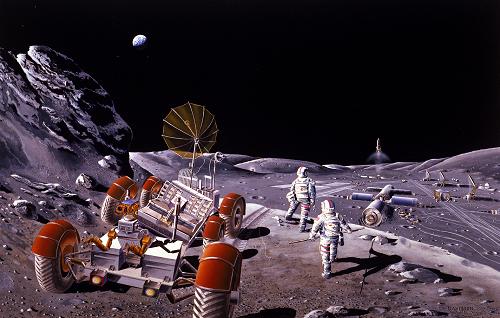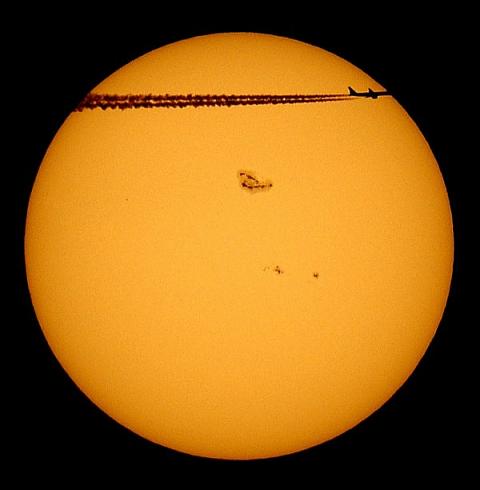The strongest solar storm in the last 15 years occurred last week. NASA researchers say that it could have harmed humans if they were stationed on the moon today.

Astronauts in a future colony on the moon. Illustration: NASA
NASA will return to the moon and not only with robots but with humans. In the coming decades we can expect to see residential facilities, greenhouses and power plants up there. The astronauts will also go into dust and craters to explore, locate resources and build. However, last week humans did not walk on the moon. and better this way.
On January 20, 2005, a giant sunspot, NOAA 720 exploded. The eruption caused an X-type solar flare, the most powerful type, which caused a billion-ton cloud of ionized gas to be thrown into space (a coronal mass ejection).
The protons are accelerated almost to the speed of light and the eruption reaches the area of the earth and the moon minutes after the flame - the beginning of a day full of proton storm.
Here on Earth no one was hurt. The thick atmosphere and the magnetic field protect us from the sun's radiation. Actually the storm was good. When the heavy angular mass arrives 36 hours later and hits Earth's magnetic field, sky watchers in Europe can see the most beautiful and brightest aurora in years.
On the moon the story is different.
The moon is completely exposed to solar storms, explains solar physicist David Hathaway from NASA's Marshall Space Flight Center. "It does not have an atmosphere or a magnetic field to moderate the radiation. The protons flying to the moon simply hit the ground - and whoever is wandering on it.
The January 20th proton storm was, according to measurements, the largest since 1989. It was particularly rich in fast protons storing 100 million electron volts of energy. Such protons can penetrate through 11 centimeters of water, so a thin space suit may offer little resistance. "An astronaut caught outside when a solar storm hits will get sick," says Francis Cucinotta, who is in charge of radiation at NASA's Johnson Space Center. At first he will feel fine, but a few days later the symptoms of radiation sickness will start to appear: vomiting, fatigue, low blood count. These symptoms may last for days.
The astronauts on the International Space Station were safe. The International Space Station is well protected. In addition, the station orbits the Earth within the protection belt of the magnetic field. "The crew members suffered no more than one rem. Cucinotta says. One REM, acronym for Roentgen Equivalent Man or radiation equivalent to X-ray radiation is the amount of radiation that causes the same damage to human tissues as exposure to one X-ray. One dental photo, for example
Exposing the patient to one-tenth of REM. According to the space station crew, the January 20th proton storm was equivalent to 10 dental x-rays, scary but not harmful.
On the Moon, astronauts protected only by spacesuits would absorb about 50 REM of ionizing radiation. This is enough to cause radiation sickness. "But this is not lethal radiation." added "To die, you would need to suddenly absorb 300 REM or more.
The key word is "suddenly". It is possible to absorb 300 REM if the radiation is spread over several days or weeks with very few effects. Dispersing the radiation gives the body time to repair and replace the damaged cells. However, if all 300 REMs come at once "we estimate that 50 percent of people exposed to radiation will die within 60 days without medical treatment." Cucinotta says.
Radiations of this magnitude are possible and the most notable example is the mythical giant storm of August 1972. It is mythical to NASA because it occurred during the Apollo program where astronauts flew back and forth to the moon regularly. At the same time, the crew of Apollo 16 returned to Earth in April, while the crew of the Apollo 17 spacecraft, the last in the series, was preparing for its landing on the moon in December. Luckily everyone was safe on Earth when the sun went berserk.
The giant sunspot, No. 720 (and a passing plane) was photographed by amateur astronomer Jan Koeman from the Netherlands on January 15, 2005.
Simulation of a solar storm. Credit: SOHO
A giant sunspot appeared on August 2, 1972, and for the next ten days it erupted repeatedly, Hathaway noted. The burst flux caused a proton storm much worse than the one we just experienced," Cucinotta said. Researchers are still studying this 1972 eruption ever since.
Cuccinotta estimates that a man walking on the moon at the end of 1972 might have spooked 400 REM. Is it a deadly force? Not necessarily. said. A quick flight back to Earth and medical treatment could have saved the hypothetical astronaut's life.
Obviously, now, no astronaut would go out and walk around on the lunar surface when there is a risk of an eruption. "They will have to stay inside the spacecraft or the living facility" says Cuccinotta.
The Apollo command vehicle with its aluminum walls would have weakened the impact from 400-500 Ram to less than 35 Ram and at least protect the circulatory system. This is the difference between a bone marrow transplant and just a headache pill.
Modern spaceships are even safer. "We measure the level of protection of the ships in units of density per area or grams per square meter, said Cucinotta. Higher numbers representing higher compression are better.
The density of the Apollo command vehicle was 7-8 grams per square meter. The wall of modern spaceships has a density of 10-11 grams per square meter. The side of the International Space Station is the safest - 15 grams per square meter.
The planned lunar bases will contain radiation receivers made of polyethylene and aluminum and will provide protection at 20 grams per square meter.
However, a typical space suit, for your time, is built with a density of 0.25 grams per square meter, and offers little protection. "Therefore this is the reason why it is desirable to be inside when a proton storm approaches." Cucinotta says.
But the moon is signaling us and when the researchers get there they won't want to stay inside. Precautions: Like the researchers on Earth, they will be able to check the weather forecast - the space weather forecast: are there large sunspots on the surface, what are the chances of a proton storm, is a coronal mass ejection approaching. Everything is fine, you can go out.
Video
For a video showing the seahorse-shaped solar flare in August 1972

